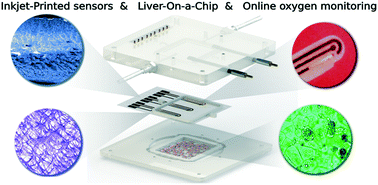Our official English website, www.x-mol.net, welcomes your
feedback! (Note: you will need to create a separate account there.)
Online oxygen monitoring using integrated inkjet-printed sensors in a liver-on-a-chip system†
Lab on a Chip ( IF 6.1 ) Pub Date : 2018-06-01 00:00:00 , DOI: 10.1039/c8lc00456k A. Moya 1, 2, 3, 4, 5 , M. Ortega-Ribera 5, 6, 7, 8, 9 , X. Guimerà 9, 10, 11, 12 , E. Sowade 13, 14, 15, 16 , M. Zea 1, 2, 3, 4, 5 , X. Illa 1, 2, 3, 4, 5 , E. Ramon 1, 2, 3, 4, 5 , R. Villa 1, 2, 3, 4, 5 , J. Gracia-Sancho 5, 6, 7, 8, 9 , G. Gabriel 1, 2, 3, 4, 5
Lab on a Chip ( IF 6.1 ) Pub Date : 2018-06-01 00:00:00 , DOI: 10.1039/c8lc00456k A. Moya 1, 2, 3, 4, 5 , M. Ortega-Ribera 5, 6, 7, 8, 9 , X. Guimerà 9, 10, 11, 12 , E. Sowade 13, 14, 15, 16 , M. Zea 1, 2, 3, 4, 5 , X. Illa 1, 2, 3, 4, 5 , E. Ramon 1, 2, 3, 4, 5 , R. Villa 1, 2, 3, 4, 5 , J. Gracia-Sancho 5, 6, 7, 8, 9 , G. Gabriel 1, 2, 3, 4, 5
Affiliation

|
The demand for real-time monitoring of cell functions and cell conditions has dramatically increased with the emergence of organ-on-a-chip (OOC) systems. However, the incorporation of co-cultures and microfluidic channels in OOC systems increases their biological complexity and therefore makes the analysis and monitoring of analytical parameters inside the device more difficult. In this work, we present an approach to integrate multiple sensors in an extremely thin, porous and delicate membrane inside a liver-on-a-chip device. Specifically, three electrochemical dissolved oxygen (DO) sensors were inkjet-printed along the microfluidic channel allowing local online monitoring of oxygen concentrations. This approach demonstrates the existence of an oxygen gradient up to 17.5% for rat hepatocytes and 32.5% for human hepatocytes along the bottom channel. Such gradients are considered crucial for the appearance of zonation of the liver. Inkjet printing (IJP) was the selected technology as it allows drop on demand material deposition compatible with delicate substrates, as used in this study, which cannot withstand temperatures higher than 130 °C. For the deposition of uniform gold and silver conductive inks on the porous membrane, a primer layer using SU-8 dielectric material was used to seal the porosity of the membrane at defined areas, with the aim of building a uniform sensor device. As a proof-of-concept, experiments with cell cultures of primary human and rat hepatocytes were performed, and oxygen consumption rate was stimulated with carbonyl-cyanide-4-(trifluoromethoxy)phenylhydrazone (FCCP), accelerating the basal respiration of 0.23 ± 0.07 nmol s−1/106 cells up to 5.95 ± 0.67 nmol s−1/106 cells s for rat cells and the basal respiration of 0.17 ± 0.10 nmol s−1/106 cells by up to 10.62 ± 1.15 nmol s−1/106 cells for human cells, with higher oxygen consumption of the cells seeded at the outflow zone. These results demonstrate that the approach of printing sensors inside an OOC has tremendous potential because IJP is a feasible technique for the integration of different sensors for evaluating metabolic activity of cells, and overcomes one of the major challenges still remaining on how to tap the full potential of OOC systems.
中文翻译:

在肝片系统中使用集成的喷墨打印传感器进行在线氧气监测†
随着芯片上器官(OOC)系统的出现,对细胞功能和细胞状况进行实时监控的需求已大大增加。但是,将共培养物和微流体通道合并到OOC系统中会增加它们的生物学复杂性,因此使设备内部分析参数的分析和监控更加困难。在这项工作中,我们提出了一种将多个传感器集成在片上肝脏设备内部极薄,多孔且细腻的膜中的方法。具体而言,沿着微流控通道喷墨打印了三个电化学溶解氧(DO)传感器,从而可以在线监测氧浓度。这种方法证明大鼠肝细胞和32种肝细胞存在高达17.5%的氧梯度。沿底部通道的人肝细胞为5%。这种梯度被认为对于肝脏分区的出现至关重要。喷墨打印(IJP)是本技术的选择,因为它允许按需滴落材料沉积,从而与脆弱的基材兼容,如本研究中所使用的那样,该材料不能承受高于130°C的温度。为了在多孔膜上沉积均匀的金和银导电墨水,使用SU-8介电材料的底漆层用于在限定区域密封膜的孔隙率,目的是构建均匀的传感器设备。作为概念验证,进行了人类和大鼠原代肝细胞的细胞培养实验,并用羰基氰化物-4-(三氟甲氧基)苯基hydr(FCCP)刺激了耗氧率,从而使基础呼吸加快了0.23±0 。-1 / 10 6细胞,最高5.95±0.67 nmol s -1 / 10 6细胞,用于大鼠细胞,基础呼吸0.17±0.10 nmol s -1 / 10 6细胞,最高可达10.62±1.15 nmol s -1 / 10 6个细胞用于人类细胞,其流出区接种的细胞耗氧量更高。这些结果表明,在OOC内打印传感器的方法具有巨大的潜力,因为IJP是一种可行的技术,可以集成各种传感器来评估细胞的代谢活性,并且克服了如何充分发挥潜力的主要挑战之一。 OOC系统。
更新日期:2018-06-01
中文翻译:

在肝片系统中使用集成的喷墨打印传感器进行在线氧气监测†
随着芯片上器官(OOC)系统的出现,对细胞功能和细胞状况进行实时监控的需求已大大增加。但是,将共培养物和微流体通道合并到OOC系统中会增加它们的生物学复杂性,因此使设备内部分析参数的分析和监控更加困难。在这项工作中,我们提出了一种将多个传感器集成在片上肝脏设备内部极薄,多孔且细腻的膜中的方法。具体而言,沿着微流控通道喷墨打印了三个电化学溶解氧(DO)传感器,从而可以在线监测氧浓度。这种方法证明大鼠肝细胞和32种肝细胞存在高达17.5%的氧梯度。沿底部通道的人肝细胞为5%。这种梯度被认为对于肝脏分区的出现至关重要。喷墨打印(IJP)是本技术的选择,因为它允许按需滴落材料沉积,从而与脆弱的基材兼容,如本研究中所使用的那样,该材料不能承受高于130°C的温度。为了在多孔膜上沉积均匀的金和银导电墨水,使用SU-8介电材料的底漆层用于在限定区域密封膜的孔隙率,目的是构建均匀的传感器设备。作为概念验证,进行了人类和大鼠原代肝细胞的细胞培养实验,并用羰基氰化物-4-(三氟甲氧基)苯基hydr(FCCP)刺激了耗氧率,从而使基础呼吸加快了0.23±0 。-1 / 10 6细胞,最高5.95±0.67 nmol s -1 / 10 6细胞,用于大鼠细胞,基础呼吸0.17±0.10 nmol s -1 / 10 6细胞,最高可达10.62±1.15 nmol s -1 / 10 6个细胞用于人类细胞,其流出区接种的细胞耗氧量更高。这些结果表明,在OOC内打印传感器的方法具有巨大的潜力,因为IJP是一种可行的技术,可以集成各种传感器来评估细胞的代谢活性,并且克服了如何充分发挥潜力的主要挑战之一。 OOC系统。











































 京公网安备 11010802027423号
京公网安备 11010802027423号